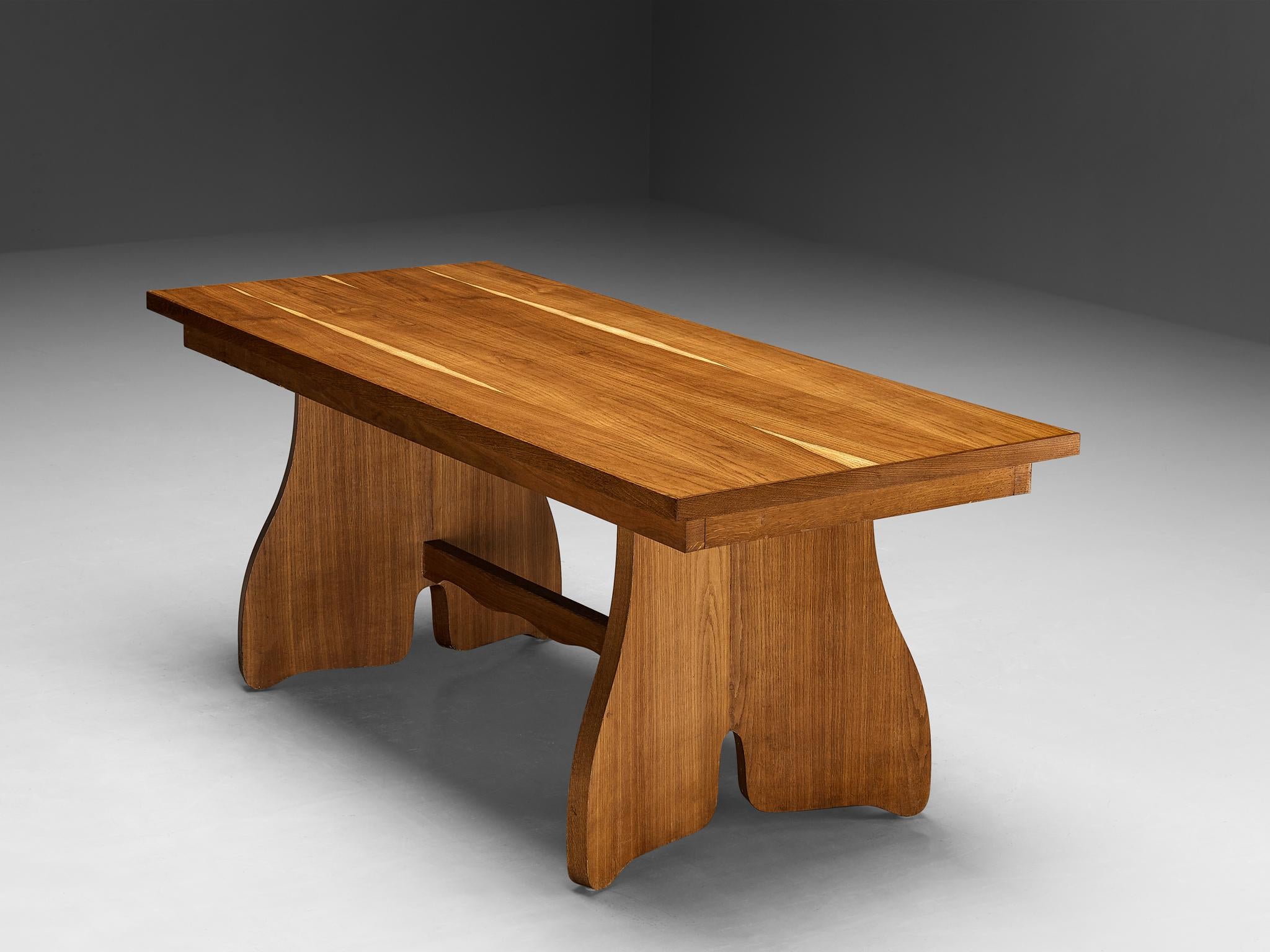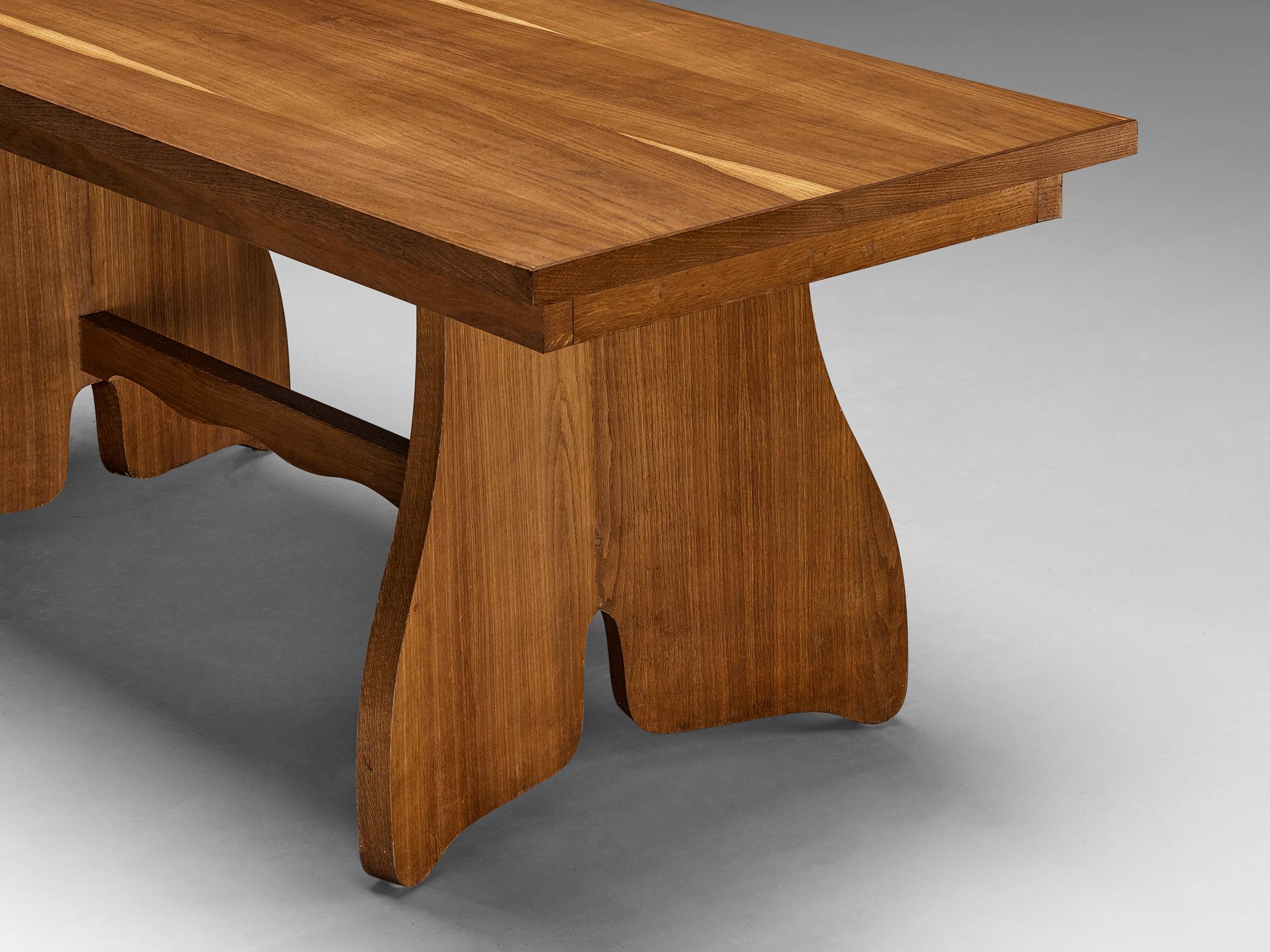







Paolo Buffa for Esposizione Permanente mobili Cantù Dining Table in Oak
Paolo Buffa for Esposizione Permanente mobili Cantù, dining table, oak, Italy, 1940s
A truly remarkable piece of furniture that excels in every aspect of design: from its impeccable execution and charmingly crafted carvings to its craftsmanship and meticulous attention to detail. This rare table is designed by the visionary Italian designer and architect Paolo Buffa (1903-1970). The base revolves around an organic rhythm with elaborate curvatures and undulating lines. The beam that allows for extra support is embellished with a carved, wavy pattern, a motif favored by renowned Italian designers of that era, including Lina Bo Bardi, Carlo Pagani, and Mario Quarti. The oakwood is characterized by a pleasant warm tone and expressive grain patterns, imparting the piece with a naturalistic allure. Buffa’s minimal use of decoration allows the distinctive properties of the wood to stand out, with the undulating curves serving as the defining elements.
Paolo Buffa (born 1903, Milan – died 1970, Milan), a distinguished figure in the world of Italian furniture design and architecture, graced the scene with his unmistakable style for a span of almost fifty years. Buffa’s artistic repertoire is notably distinguished by his expert fusion of neoclassical and sleek Art Deco formal elements. Crafted with finesse and elegance, Buffa’s premium-quality pieces were fashioned from refined materials, with the explicit purpose of furnishing the homes of a discerning and affluent clientele. These furniture creations were tailored to meet the demands of individuals who were inclined towards contemporary aesthetics, functionalism, and comfort. Buffa’s creative repertoire extended beyond furniture design to architecture, and he undertook an array of commissions that spanned public buildings, as well as villas and country homes.
Paolo Buffa’s formative years were spent amidst an artistic milieu, having been born to Giovanni Buffa, a renowned draftsman of ex- ceptional talent. Giovanni Buffa shared ownership of a highly pros- perous workshop dedicated to the creation of exquisite stained glass artistry. Among his notable works are the stained glass windows of the illustrious Duomo di Milano, a historic cathedral located in Milan. Such a creative household fostered an environ- ment of artistic excellence, which undoubtedly played a crucial role in shaping Paolo Buffa’s artistic sensibilities.
Buffa’s artistic training commenced at the prestigious Accademia di Belle Arti di Brera, and he eventually obtained his degree from the Politecnico di Milano in 1927. After gaining experience working in his father’s studio, Buffa went on to work as an apprentice at the Ponti e Lancia studio, which was jointly owned by the celebrated architects Gio Ponti (1891- 1979) and Emilio Lancia (1890-1973). This experience proved to be a significant turning point in Buffa’s career, as he drew inspiration from Lombard Neoclassicism and was exposed to the ideas and concepts of some of the most prominent architects of the region. He assimilated these teachings and employed them in his own work, which was characterized by a fusion of traditional Lombard woodworking techniques and modern design aesthetics.
In 1928, Paolo Buffa founded his own design studio in Milan in partner- ship with architect Antonio Cassi Ramelli (1905-1980). Here, they pro- duced an extensive collection of furniture designs that drew inspiration from the classical revival style, albeit with a softened touch. In 1936, Buffa branched out on his own to establish an independent studio. He made a name for himself by showcasing his work at exhibitions, including the prestigious Triennale di Milano. Buffa’s furnishings were numerous and varied, but always tailored to the specific needs and desires of his discerning clients. Each piece was crafted to perfection by highly skilled artisans, such as cabinetmakers Turri Mosè, Fratelli Lietti, Quarti, Serafino Arrighi, Colico, and Angelo Marelli. Buffa’s passion for design persisted throughout his life, and he remained actively engaged in the field until his death in 1970.
VAT within the EU: When buying or delivering an item within the EU, VAT usually applies and will be added.
Choose options








Product Details